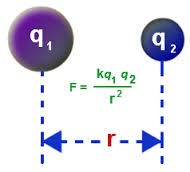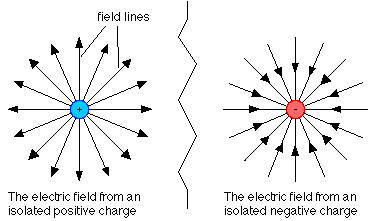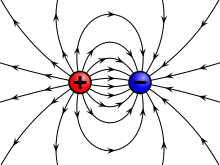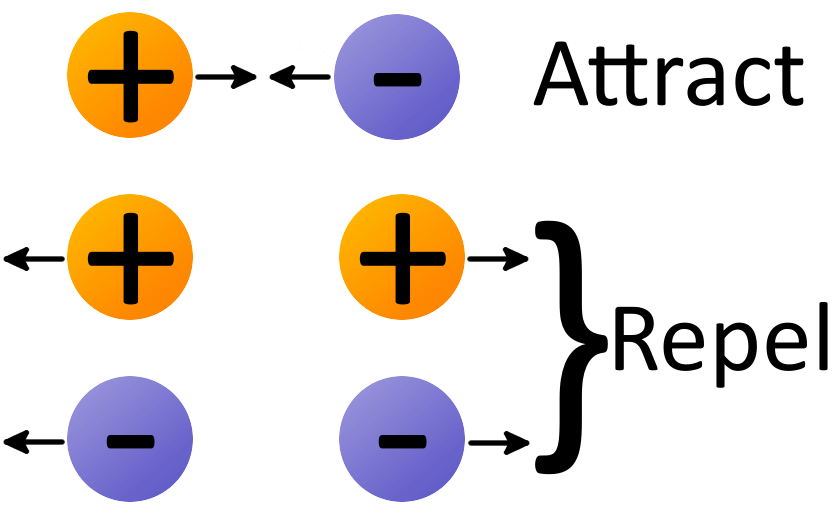Electric Charge is that physical property of matter due to which the other matter experience a force when matters are placed in electromagnetic field. Electric charge is also known as Charge, Electrical Charge and Electrostatic Charge. It is denoted by symbol ‘q’. It is a scalar quantity as charge has only magnitude and no direction.The two types of charges exist in nature: Positive and Negative Charge.Same charge repels each other and opposite charge attract each other. In the figure given below, we can see that like charge are repelling each other, while opposites are attracting each other.We know that in a nucleus proton and neutron exists while electron revolve around the nucleus. Proton (p+) have positive charge and electron (e-) have negative charge. As symbol of proton is (p+) so proton carrying positive charge and symbol of electron is (e-) so electron carrying negative charge. As number of proton and electron in a nucleus are equal so net charge on nucleus is zero.For existing the net charge on a body the sum of positive and negative charge should be equal to zero.Properties of Electric Charge
Electric Field
It is the region around a charge particle or object due to which another charge particle or object experience force. Electric Field is a vector quantity so we must consider the sign in numerical.Formula of Electric FieldUnit of electric field: E = N/CAs, unit of force is Newton (N) and charge is Coulomb ( C), So unit of electric field is N/C.Note: While writing the unit 1st letter should be capital.In the above formula F is the force and q is the charge. F is calculated in terms of coulombs law.Coulombs law is stated as force acting on a charge particle due to another charge particle is directly proportional to product of their charges and inversely proportional to square of distance between the charges.Where, k is the proportionality constant and its value is 9 * 109 Nm2/C2. It is different for different medium.SI unit of F is = N m2 C2/C2 m2So, on solving above equation we get F = Newton (N)How to calculate SI Unit of any Physical Quantity?
These four quantities are the basic quantities with the help of these quantities we can find the SI unit of any other physical quantity.We, know that formula of E is = F/qSo, SI unit of F is Newton and Charge is Coulomb.E = N/CHow to calculate the Direction of E?
Direction of Electric Field is always from positive charge to negative charge. In terms of single positive charge Electric field move away from the positive charge as shown in the first part of the diagram and in terms of negative charge Electric field move towards the negative charge as shown in the second part of the diagram.In the above diagram, we can see that in terms of positive charge E is moving away from positive charge Similarly in terms of negative charge E moving away from negative charge.Diagram of E in terms of two Charges
In this diagram, all the three directions are used. Firstly, Electric field goes from Positive charge to negative charge. Secondly, In terms of positive charge field lines are moving away from positive charge and in terms of negative charge field lines are coming towards the charge.Frequently Asked Questions (FAQs)
Q1. Two insulated charge sphere A and B of identical size having charges qA and -3qA respectively. When they are brought in contact with each other and then separated what are the new charges on them?Sol. As two charges are of opposite sign, they will attract each other so there will be the simple addition of charge.New charge on them is Q = (qA) + (-3qA / 2)Q = -qAQ2. What is the basic condition for existing the net charge on a body?Sol. The basic condition for existing the net charge on a body is that number of positive and negative charge should not be equal to zero.Q3. What is the Charge on Electron?Sol. Charge on electron is -1.6 *10-19 C.Q4. Is the force acting between two point charges q1 and q2 kept at some distance apart, attracting or repulsive (a) q1 q2 > 0 (b) ) q1 q2 < 0 ?Sol.(a) If q1 q2 > 0 then the force is repulsive because if both the charges are positive and negative (same charges) only then their product is greater than zero. We know that same charges always repel each other.(b) If q1 q2 < 0 then the force is attractive because one charge will be positive and other will be negative and opposite charge attract each other.Q5. What is the SI unit of Electric Field?Sol. SI unit of electric field is N/C.Q6. What is the Dimensional Formula of Electric Field?Sol. The dimensional formula of electric field is [MLT-2C-1].Q7. If two charges having equal magnitude are separated by unit distance and exert a force of 15 N on each other. What will be the force exerted by the same charges kept at same distance but the charges are placed in water?Sol.F1 = 15 N, r1 = 1 meter, k air = 1 , q1 = q2 = qF2 = 15 N, r2 = 1 meter, k water = 80F1 = k air q1 q2 / r2, F2 = k water q1 q2 / r2F2 = k water q1 q2 / r2F2 = 80 * q2/ 1F2 = 80 q2 N.Q8. Two spheres of radius r1 and r2 are connected by a wire. What will be the ratio of their electric field?Sol. We know that F= k q1 q2/r2 and E = F/q.So, E1/E2 = r22/r12.What is Electric Charge?
Electric Charge is a physical property of matter due to which a matter experience a force on another charge matter when placed in electromagnetic field (electric or magnetic field).Another Definition of Electric Charge
According to Franklin electric charge is used for electrostatic interaction. For Example: A body can interact with another body only if charge is present in that body.
What is the definition of charge in daily life?
In daily life we use the term charge many times. For Example: charging a phone. We can charge an object when we apply voltage to it.Q= CVQ = Charge, C = Capacitance, V= Voltage.How Charge Originate?
It was assumed that origin of charge start from atomic structure. Let us consider a atom having size 10 -10 meter. Inside the atom nucleus in present and size of nucleus is 10 -15 meter. Electrons revolve around the nucleus. As we know that symbol of proton is (P + ) so charge on proton is + and symbol of electron is (e – ) and charge on electron is – so from sign convention we can tell that the object is positively charged or negatively.In the above figure we can see that how charge originate from the atomic structure. From the atom electrons and protons originate.What is SI unit of Charge?
What is Elementary Charge?
Elementary Charge is the magnitude of charge carried by single electron or proton. The charge on electron is negative and it is denoted by (-e) while the charge on proton is positive and it is denoted by (+e).The charge on single proton is (+ 1.6 * 10 -19 C ) while the charge on single electron is (- 1.6 * 10 -19 C).How many types of charge exist in nature?
There are two types of charge exists in nature:
- Positive Charge
- Negative Charge
“Same charge repel each other and opposite charge attract each other”In the diagram given below we can see that same charge repel each other and opposite charge attract each other.Note : In case of neutral charge number of positive charge is equal to the number of negative charge but neutral charge is not considered the type of charge. There are only two types of charge exist. For Example: Positive and Negative.What are the Properties of Electric Charge?
How Electrons Come out from the Neutral Object?
Let us consider a neutral object (equal number of proton and electron). In neutral object each electron is attracted to each proton (because number of positive charge is equal to number of negative charge). The force we are applying to pull electrons from the object is equal to the force which is pulling back electrons to the charged object because amount of positive charge is equal to the negative charge, so both forces cancel out with each other. So we have to do some external work to pull the electrons from the object.There are various method to pull the electrons from the surface.
How can we charge an object?
How Electric Field can generate from Charge?
In case of positive charge direction of electric field is away from the charge while in case of negative charge direction of electric field is towards the charge as shown in the figure.What is Current?
Current may be defined as charge flowing through a closed circuit per unit time.Another Definition of Electric Current
A current is said to be one Ampere if charge of one Coulomb flows through a point in one Second.I = q/tIn above figure, current is flow in the circuit when we apply the voltage to the circuit the charge generates and electrons flows in the circuit. The direction of current is opposite to the direction of flow of electrons.What is Formula of Current?
I = q/tWhere, I is the current flowing in the circuitt is the time.What is SI Unit of Current?
SI unit of current is Ampere.What is Dimensional Formula of Current?
Dimensional formula of current is [ CS-1 ].Frequently Asked Questions (FAQs)
Q1. What is the definition of charge?Sol. A charge is said to be one coulomb if one Ampere current flows in a circuit in one second.Q2. What are positive and negative charge?Sol. A neutral atom becomes an ion if it loose or gain electron or proton. As we know that neutral atom don’t have any charge it becomes positive charge if it loose electron and it becomes negative charge if it gain electron.Q3. What is the unit for measurement of charge?Sol. The unit for measurement of charge is coulomb.Q4. What is an electric current?Sol. Electric current is the ratio of charge per unit time.Q5. Why do two electrons repel each other?Sol. Two electrons repel each other because both the electrons have same charge. For Example: Negative and we know that same charge repel each other.
We are Leading Institute providing Regular / Vedioes / Live Coaching under NVIE Trust . We Provides Coaching For Classes 1 to 12 (CBSE - CHSE - ICSE - HSC ). We also provide NEET - JEE -OUAT Entrance Preparation for +2 Science Student . We provide Bank - Railway - SSC - OTET - OSSTET - B.Ed Odisha - CT Odisha - Others Entrance Coaching for graduate .
Join Us ! Join Us ! Join Us !
Get the best possible FREE NOTES -VEDIOES .B.Ed Notes for Andra Pradesh States. English Grammer Notes.CHSE | ICSE | CBSE Notes Class 6 to 12 .
A call-to-action text Contact us
Labels
- Air Around us Class 6 Chemistry Vedioes
- Application and role of teacher
- Areas Parallelograms & Triangles Class 9 Mathematics Vedioes
- Atoms & Molecules Class 9 Chemistry Vedioes
- Atoms & Nuclei
- B.Ed (1st Semester)
- BIOLOGY Class 6 Vedioes
- BIOLOGY Class 9 Vedioes
- Body Movement Class 6 Biology Vedioes
- Buddhist Education and Jains) B.Ed 1at Sem Notes
- Changes Around us Class 6 Chemistry Vedioes
- Changing roles of the learner and the teacher in ICT-Integration and Challenges
- Characteristics and features of Computers
- CHEMISTRY
- CHEMISTRY Class 6 Vedioes
- CHEMISTRY Class 9 Vedioes
- Circles Class 9 Mathematics Vedioes
- CLASS 12 PHYSICS
- Classroom Communication and Communicative Skills for Teachers and Students
- Component of Food Class 6 Biology Vedioes
- Components of Computers – Hardware
- CONCEPT OF GROWTH
- Constructions Class 9 Mathematics Vedioes
- Coordinate Geometry Class 9 Mathematics Vedioes
- Current Electricity
- development
- DEVELOPMENT & MATURATION
- Dimensions of Individual differences B.Ed 1st Sem Notes
- DIMENSIONS OF THE GROWTH AND DEVELOPMENT
- Diversity In Living Organisms Class 9 Vedioes
- Eastern Systems of Philosophy B.Ed 1st Sem Notes
- Education during Ancient Period (Vedic Education
- Education during Medieval Period (Including Islamic Education) B.Ed 1st Sem Notes
- Education during Modern Period B.Ed Sem1 Notes
- Education during Modern Period-2 B.Ed Sem-1 Notes
- Education During Modern Period-3 B.Ed 1St Sem Notes
- Electric Charges and Fields
- Electricity & Circuits Class 6 Physic
- Electromagnetic Induction
- Electrostatic Potential and Capacitance
- ELT and Social Networking B.ed 1st sem Notes
- Euclid’S Geometry Class 9 Mathematics Vedioes
- Fiber to Fabric Class 6 Chemistry
- Food: Where does it come from? Class 6 biology Vedioes
- Force & Laws of Motion Class 9 Vedioes
- Fractions Class 6 Math
- Fun with Magnets Class 6 Physic Vedioes
- Fundamental Unit of Life Class 9 Vedioes
- Garbage in
- Garbage out Class 6 Biology Vedioes
- Getting to know Plants Class 6 Biology vedioes
- Gravitation Class 9 Vedioes
- Heron’S Formula Class 9 Mathematics Vedioes
- Hindi Nios (201) बुक 1 डाउनलोड करने के लिए क्लिक करें
- Important Question "Approaches of Human Development"
- Improvement Food Resources Class 9 Vedioes
- Individualised Instruction – Concept
- Integers Class 6 Math
- Is Matter Around Us Pure Class 9 Chemistry Vedioes
- Knowing Your Numbers Class 6 Math
- Knowledge Acquisition and Multi-sensory approach
- Light Shadow & reflection Class 6 Vedioes
- Linear Equations In 2 Variables Class 9 Mathematics Vedioes
- Lines & Angles Class 9 Mathematics Vedioes
- Living Organisms & Surroundings Class 6 Biology Vedioes
- LONGITUDINAL AND CROSS-SECTIONAL APPROACHES OF UNDERSTANDING DEVELOPMENT
- Mathematics 10TH NIOS PDF
- MATHEMATICS Class 6
- MATHEMATICS Class 9 Vedioes
- Matter In Our Surroundings Class 9 Chemistry Vedioes
- Memory and Maintenance of Computers
- modes of presentation
- Motion & Measurement of Distance Class 6 Vedioes
- Motion Class 9 Vedioes
- Moving Charges and Magnetism
- multimedia and webpage creator
- Need
- Number Systems Class 9 mathematics Vedioes
- Online resources for ELT B.ed 1st Sem Notes
- Operating Systems - DOS
- Page Layout
- PHYSICS Class 9 Vedioes
- PHYSICS STD. 6 Vedioes Classes
- Playing with Numbers Class 6 Math
- Polynomials Class 9 Mathematics Vedioes
- Presentation
- Principles and Techniques
- PRINCIPLES OF DEVELOPMENT
- Probability Class 9 Mathematics Vedioes
- Programmed Learning - Principles
- Quadrilaterals Class 9 Mathematics Vedioes
- Ray Optics and Optical
- Science & Technology 10TH NIOS
- Separation of Substance Class 6 Chemistry Vedioes
- Software
- Software for Word Processing
- Sorting of Materials Class 6 Chemistry Vedio
- Sound Class 9 Vedioes
- Stages of Growth and Development in Children
- Statistical & Graphical
- Statistics Class 9 Mathematics Vedioes
- Structure of The Atom Class 9 Chemistry Vedioes
- Surface Areas & Volumes Class 9 Mathematics Vedioes
- Teaching of Poetry B.Ed 1st Sem Notes
- Teaching of Prose B.Ed 1st Sem Eng
- The Solid State
- Tissues Class 9 Vedioes
- Triangles Class 9 Mathematics Vedioes
- Types
- Understanding Elementary Shapes Class 6 Math
- Use of Multi-media in ELT B.Ed 1st Sem Notes
- Water Class 6 Biology Vedioes
- Wave Motion
- Wave Optics
- Western Schools of Philosophy B.Ed 1st Sem Notes
- Whole Numbers Class 6 Math
- Why Do We Fall Ill Class 9 Vedioes
- Windows and Macintosh and Mobile Apps for Teaching
- Work & Energy Class 9 Vedioes
About
3/random/post-list













